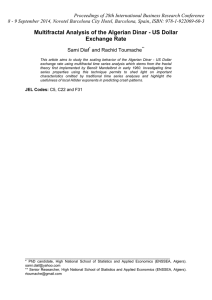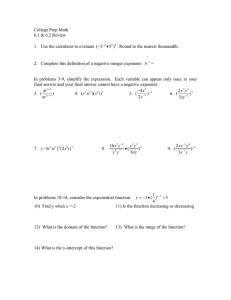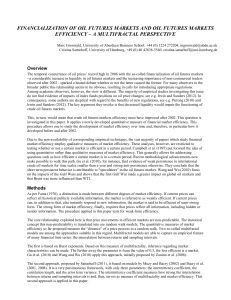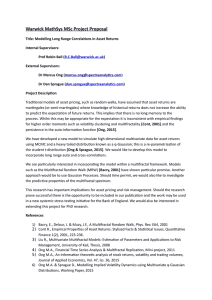A Multifractal Description of Wind Speed Records
advertisement
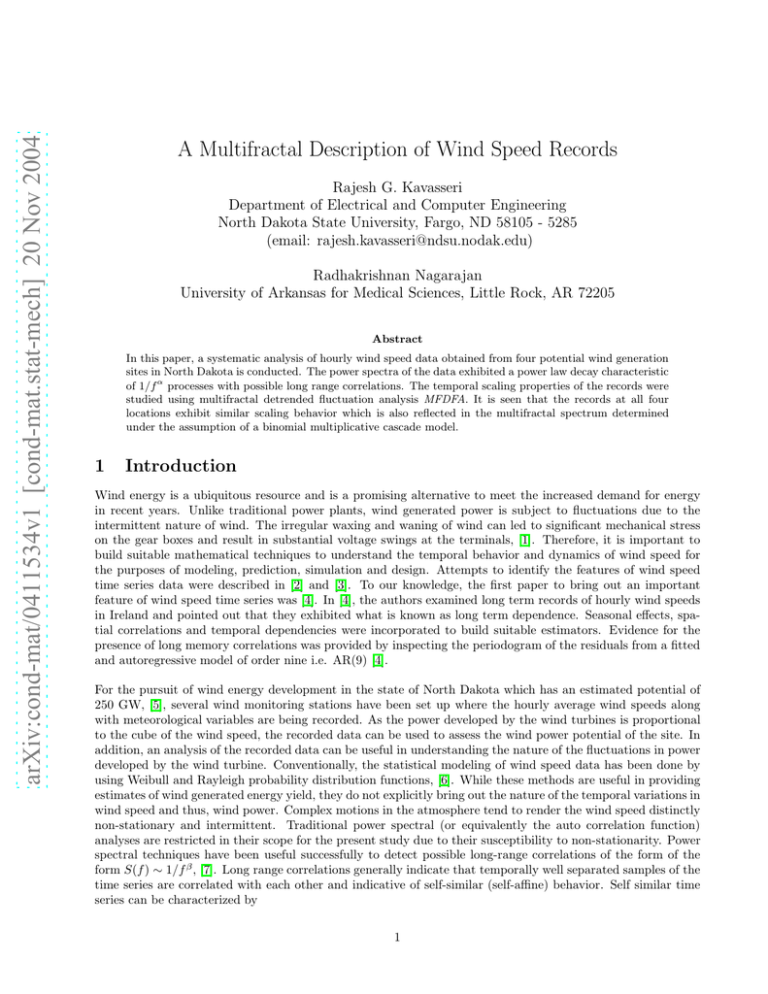
arXiv:cond-mat/0411534v1 [cond-mat.stat-mech] 20 Nov 2004
A Multifractal Description of Wind Speed Records
Rajesh G. Kavasseri
Department of Electrical and Computer Engineering
North Dakota State University, Fargo, ND 58105 - 5285
(email: rajesh.kavasseri@ndsu.nodak.edu)
Radhakrishnan Nagarajan
University of Arkansas for Medical Sciences, Little Rock, AR 72205
Abstract
In this paper, a systematic analysis of hourly wind speed data obtained from four potential wind generation
sites in North Dakota is conducted. The power spectra of the data exhibited a power law decay characteristic
of 1/f α processes with possible long range correlations. The temporal scaling properties of the records were
studied using multifractal detrended fluctuation analysis MFDFA. It is seen that the records at all four
locations exhibit similar scaling behavior which is also reflected in the multifractal spectrum determined
under the assumption of a binomial multiplicative cascade model.
1
Introduction
Wind energy is a ubiquitous resource and is a promising alternative to meet the increased demand for energy
in recent years. Unlike traditional power plants, wind generated power is subject to fluctuations due to the
intermittent nature of wind. The irregular waxing and waning of wind can led to significant mechanical stress
on the gear boxes and result in substantial voltage swings at the terminals, [1]. Therefore, it is important to
build suitable mathematical techniques to understand the temporal behavior and dynamics of wind speed for
the purposes of modeling, prediction, simulation and design. Attempts to identify the features of wind speed
time series data were described in [2] and [3]. To our knowledge, the first paper to bring out an important
feature of wind speed time series was [4]. In [4], the authors examined long term records of hourly wind speeds
in Ireland and pointed out that they exhibited what is known as long term dependence. Seasonal effects, spatial correlations and temporal dependencies were incorporated to build suitable estimators. Evidence for the
presence of long memory correlations was provided by inspecting the periodogram of the residuals from a fitted
and autoregressive model of order nine i.e. AR(9) [4].
For the pursuit of wind energy development in the state of North Dakota which has an estimated potential of
250 GW, [5], several wind monitoring stations have been set up where the hourly average wind speeds along
with meteorological variables are being recorded. As the power developed by the wind turbines is proportional
to the cube of the wind speed, the recorded data can be used to assess the wind power potential of the site. In
addition, an analysis of the recorded data can be useful in understanding the nature of the fluctuations in power
developed by the wind turbine. Conventionally, the statistical modeling of wind speed data has been done by
using Weibull and Rayleigh probability distribution functions, [6]. While these methods are useful in providing
estimates of wind generated energy yield, they do not explicitly bring out the nature of the temporal variations in
wind speed and thus, wind power. Complex motions in the atmosphere tend to render the wind speed distinctly
non-stationary and intermittent. Traditional power spectral (or equivalently the auto correlation function)
analyses are restricted in their scope for the present study due to their susceptibility to non-stationarity. Power
spectral techniques have been useful successfully to detect possible long-range correlations of the form of the
form S(f ) ∼ 1/f β , [7]. Long range correlations generally indicate that temporally well separated samples of the
time series are correlated with each other and indicative of self-similar (self-affine) behavior. Self similar time
series can be characterized by
1
y(t) ≡ aα y(t/α)
(1)
where the ≡ in Eqn.(1) denotes that both sides of the equation have identical statistical properties. The
exponent α in Eqn.(1) is called the self-similarity parameter, or the scaling exponent. Values of α in the
range (0, 0.5) characterize anti-persistence, whereas those in the range (0.5,1) characterize persistent long range
correlations with α = 0.5 representing uncorrelated noise. The exponent (β) estimated from the power spectrum
(S(f ) ∼ 1/f β ) is related to α as β = 2α − 1. The temporal trace and corresponding power spectrum of one of
the representative records is shown in Fig. 1.
25
wind speed (m/s)
20
15
10
5
Power Spectral Density (dB/ rad/sample)
0
0
2000
4000
6000
hours
8000
10000
12000
Welch PSD Estimate
20
10
0
−10
−20
0
0.1
0.2
0.3
0.4
0.5
0.6
0.7
Normalized Frequency (×π rad/sample)
0.8
0.9
1
Figure 1: Temporal trace and Power spectrum of a representative record
Examining the power spectrum of the wind speed indicates a power-law decay of the form S(f ) ∼ 1/f β . The
auto-correlation functions (ACF) decay slowly to zero and the first zero crossing of the ACFs occur at lags of
61,56,60 and 57 respectively for the four data sets. Such features are characteristic of statistically self similar
processes with well defined power law correlations, [7].
Estimating the Hurst exponent (H) from the given data is an alternate effective way to determine the nature
of the correlations in it [8]. Hurst exponents have been successfully used to quantify long range correlations in
plasma turbulence [9], [10], finance [11], [12], network traffic, [13] and physiology, [14]. Long range correlations
are said to exist if 0.5 < H < 1 (see [15], [16] for details). There are several methods such as the variance
method, re-scaled range (R/S) analysis, Whittle estimator and wavelet based methods to estimate the Hurst
exponent. Hurst estimators are susceptible to such artifacts such as polynomial trends which cannot be ruled
out in experimental data and therefore, they may give spurious results. Recently the Detrended Fluctuation
Analysis (DFA), [17] and its extensions have been proposed as an alternate effective technique to determine
possible long range correlations in data sets obtained from a diverse settings, [18], [19], [20], [21].
It should be noted that the techniques listed above can only extract a single scaling exponent from a time series.
However, it is possible that the given process may be governed by more than one scaling exponents, in which
case a single scaling exponent would be unable to capture the complex dynamics inherent in the data. Therefore,
2
these methods are appropriate only for the analysis of monofractal signals which have uniform scaling properties
throughout the signal which can be characterized by a single exponent. On the other hand, multifractal signals
are far more complex than monofractal signals and require more than one (theoretically infinite) exponent to
characterize their scaling properties, [14].
In the present study, the wind speed time series data is studied using a fairly robust and powerful technique
called Multifractal Detrended Fluctuation Analysis (MFDFA), [22]. The method provides a systematic means to
identify and more importantly quantify the multiple scaling exponents in the data [22]. The scaling exponents
of the data are estimated under the assumption of a binomial multiplicative cascade model. This is carried out
on the wind speed data acquired from four spatially separated monitoring locations in North Dakota. The paper
is organized as follows. In Sec.2, the acquisition of wind speed data is described. In Sec. 3, a brief description
of multifractal detrended fluctuation analysis is provided. In Sec.4, the results of MFDFA and the calculation
of the multifractal spectrum is provided. The conclusions are summarized in Sec.5.
2
Data Acquisition
The hourly averaged wind speeds at four geographically well separated locations in North Dakota were recorded
by means of a conventional cup type anemometers located at a height of 20 m. The co-ordinates of the map
are provided in Table 1. From Fig.2, it can be seen that the locations are sptially well separated across North
Dakota. The wind speed data to be discussed were recorded over a time frame ranging from 11/29/2001 to
07/28/2003.
Table 1: Co-ordinates of
Station
Latitude
Site 1
N 47 27.84’
Site 2
N 46 13.03’
Site 3
N 48 52.75
Site 4
N 46 12.67’
the wind monitoring sites
Longitude
Elvn (ft)
W 99 8.18’
1570
W 97 15.10’
1070
W 103 28.4’
2270
W 103 13.07’
2880
3
1
2
4
Figure 2: A map of the wind monitoring sites
3
Multifractal Detrended Fluctuation Analysis (MFDFA)
MFDFA, [22] a generalization of DFA has been shown to reliably extract more than one scaling exponent from
a time series. A brief description of the algorithm is provided in Section III, for completeness. A detailed
explanation can be found elsewhere [22]. Consider a time series {xk }, k = 1 . . . N . The MFDFA algorithm
consists of the following steps.
3
1. The series {xk } is integrated to form the integrated series (also called “profile”) {yk } given by
y(k) =
i=k
X
[x(i) − x̄] k = 1, . . . N
(2)
i=1
where x̄ represents the average value.
2. The series {yk } is divided in to ns non-overlapping boxes of equal lengths where ns = int(N/s). To
accommodate the fact that some of the data points may be left out, the procedure is repeated from the
other end of the data set [22].
3. The local polynomial trend yv with order v is fit to the data in each box, the corresponding variance is
given by
i=s
F 2 (v, s) = {
1X
{y[N − (v − ns )s + i] − yv (i)}2
s i=1
(3)
for v = 1, . . . ns . Polynomial detrending of order m is capable of eliminating trends up to order m-1. [23]
4. The qth order fluctuation function is calculated from averaging over all segments.
Fq (s) =
(
i=2n
1 Xs 2
[F (v, s)]q/2
2ns i=1
)1/q
(4)
In general, the index q can take any real value except zero.
5. Step 3 is repeated over various time scales s. The scaling of the fluctuation functions Fq (s) versus the
time scale s is revealed by the log-log plot.
6. The scaling behavior of the fluctuation functions is determined by analyzing the log-log plots Fq (s) versus
s for each q. If the original series {xk } is power-law correlated, the fluctuation function will vary as
Fq (s) ∼ sh(q)
3.1
(5)
Multifractal Analysis
In the MFDFA procedure (Section III), the exponent h(q) describes the scaling behavior of the qth order fluctuation function. For positive values of q, h(q) describes the scaling behavior of segments with large fluctuations
while those of negative values of q, describe scaling behavior of segments with small fluctuations, [22]. For stationary time series, the exponent h(2) is identical to the Hurst exponent. Thus the exponent h(q) is called as the
generalized Hurst exponent, [22]. For monofractal time series which are characterized by a single exponent over
all scales, h(q) is independent of q, whereas for a multifractal time series, h(q) varies with q. This dependence
is considered to be a characteristic property of multifractal processes, [22].
A multifractal description can also be obtained from considering partition functions ( see [24] for details)
Zq (s) =
v=n
Xs
|yvs − y(v−1)s |q ∼ sτ (q)
(6)
v=1
where τ (q) is the Renyi exponent. A linear scaling of τ (q) with q is characteristic of a monofractal data, whereas
a nonlinear scaling is indicative of multifractal behavior. The h(q) obtained from MFDFA is related to the the
Renyi exponent τ (q) by
qh(q) = τ (q) + 1
4
(7)
Therefore, another way to characterize a multifractal series is the multifractal spectrum f (αh ) defined by, [7]
αh =
dτ (q)
, f (αh ) = qαh − τ (q)
dq
(8)
In (9), αh is the Hölder exponent which characterizes the singularities (cusps, ridges, chirps, spikes) in a process
X(t) at time t, [25]. The multifractal spectrum f (αh ) describes the singularity content of the process, i.e. the
dimension of the set of times t where αh = α, [25]. Substituting for τ (q) from Eqn.(7), we get, [22]
αh = h(q) + q
dh(q)
, f (αh ) = q[αh − h(q)] + 1
dq
(9)
The generalized exponents h(q) in Eqn.(9) can be estimated by the formula
h(q) =
1 ln(aq + bq )
−
q
qln2
(10)
assuming a binomial multiplicative cascade model [7] which has served as one of the standard paradigms to
describe multifractal scaling, (see [26], [7], [22] for details). Finally, the width of the multifractal spectrum
f (αh ) at f = 0, given by
(ln(b) − ln(a))
∆αh = h(−∞) − h(∞) =
(11)
ln2
is computed to compare the strength of multifractality for different records. Incidentally, the multifractal
spectrum can also be estimated using wavelets by the wavelet transform modulus maxima (WTMM) method,
[27] which we do not pursue here.
4
Results
The log-log plot of the fluctuation functions Fq (s) vs s for the wind speed records at all four locations with (q =
-6, -4, -2, 2, 4, 6) using fourth order polynomial detrending is shown in Fig.3. The generalized hurst exponent
h(q) estimated for (q = -6, -4, -2, 2, 4, 6) using Eqn.(5) is shown in Fig.4. One can note that at all locations,
the slopes h(q) decrease as the moment is increased from negative to positive values. For example, the slope
decreases from 0.88 when q = −6 to 0.6989 when q = +6 for site 3 which is indicative of multifractal behavior.
Recent studies have suggested the choice of constrained randomized shuffled surrogates to reject the null that
the observed scaling is due to the distribution as opposed to the temporal structure in the data. Constrained
randomized shuffles (surrogates) are similar to traditional bootstrapping without replacement, i.e. each member
in the original data is retained in the surrogate. While the temporal structure is destroyed the distribution of the
original data is retained in the surrogate realizations. The surrogate realizations are equivalent to uncorrelated
noise. A good exposition of the concepts of surrogate analysis can be found in [28]. In the present study, the
MFDFA studies are performed on random shuffle surrogates of the original data, to reject the claim that the
observed scaling exponent obtained on the original data is due to its distribution and not due to correlations
present in it. The results shown in Fig. 5 indicate that for all values of q, the fluctuations scale as Fq (s) ∼ s0.5
which signifies a loss of correlations. In other words, there is a loss of multifractality because the slopes h(q)
are independent of q. The parameters a and b determined under the assumption of a binomial multiplicative
process Eqn.(10) is also shown Fig.4. Using the values of a and b with Eqns.(5), (9) and (10), the multifractal
spectrum at all four locations shown in Fig.6 is computed. The width of the multifractal spectrum is calculated
from Eqn.(11).
5
Conclusions
In this study, the hourly wind speed records at four geographically well separated locations in North Dakota
were examined. The focus was on determining the nature of the correlations and hence, the dynamics in the
wind speed data. The power-law decay of the power spectrum suggested the presence of possible long range
correlations and self-similar behavior. A number of techniques proposed in the past to quantify self-similarity
in a given data have been susceptible to non-stationarity which can manifest itself as polynomial trends. This
5
3
3
Site 1
Site 2
2.5
2
log10(Fq(s))
log10(Fq(s))
2.5
1.5
2
1.5
1
0.5
1
0.5
(b)
(a)
0
1.5
2
2.5
log (s)
3
0
1.5
3.5
2
2.5
log (s)
10
3.5
3
3
Site 4
Site 3
2.5
2
2
log10(Fq(s))
2.5
log10(Fq(s))
3
10
1.5
1.5
1
1
0.5
0.5
(d)
(c)
0
1.5
2
2.5
log10(s)
3
0
1.5
3.5
2
2.5
3
3.5
log10(s)
Figure 3: Fluctuation functions at all sites using MFDFA. Symbols used to indicate the various moments are
q = −6 (-), q = −4(inverted triangle), q = −2 (x), q = 2 (.), q = 4 (o), q = 6 (+). The curves are vertically
shifted for clarity.
1
1
site 2
0.9
0.9
0.8
0.8
h(q)
h(q)
site 1
0.7
0.7
0.6
0.6
(a)
a = 0.515, b = 0.721
0.5
−6
−4
−2
0
q
2
4
(b)
a = 0.512, b = 0.711
0.5
−6
6
1
−4
−2
0
q
2
6
1
site 4
site 3
0.9
0.9
0.8
0.8
h(q)
h(q)
4
0.7
0.7
0.6
0.6
(c)
a = 0.493, b = 0.678
0.5
−6
−4
−2
0
q
2
4
(d)
a = 0.488, b = 0.665
0.5
−6
6
−4
−2
0
q
2
4
6
Figure 4: Generalized scaling exponents for wind speed records at the four sites. Circles indicate the actual
values of the scaling indices for q = −6, −4, −2, 2, 4 and 6. The solid line represents the fit from the multiplicative
cascade model (Eqn.(10)) obtained from a nonlinear least squares procedure. The values of a and b are indicated
for each site.
6
3
3
Site 1
2.5
(F (s))
2
1.5
10
q
1.5
1
1
log
log
10
q
(F (s))
2
0.5
0.5
0
−0.5
Site 2
2.5
0
(a)
1
1.5
2
2.5
3
−0.5
3.5
(b)
1
1.5
2
log10(s)
(F (s))
2
1.5
10
q
1.5
1
1
log
q
(F (s))
Site 4
2.5
2
10
3.5
3
Site 3
2.5
log
3
log10(s)
3
0.5
0.5
0
−0.5
2.5
0
(c)
1
1.5
2
2.5
3
−0.5
3.5
(d)
1
1.5
log (s)
2
2.5
3
3.5
log (s)
10
10
Figure 5: Fluctuation functions at all sites using MFDFA for random shuffle surrogates of the original data.
Symbols used to indicate the various moments are q = −6 (-), q = −4(inverted triangle), q = −2 (x), q = 2
(.), q = 4 (o), q = 6 (+). The curves are vertically shifted for clarity. Note that the curves are parallel to each
other with a slope of ∼ 0.5.
1
0.9
0.8
0.7
f(α)
0.6
0.5
0.4
0.3
Site 1
Site 2
Site 3
Site 4
0.2
∆α = 0.4862
∆α = 0.4720
∆α = 0.4587
∆α = 0.4475
0.1
0
0.4
0.5
0.6
0.7
0.8
0.9
1
1.1
α
Figure 6: Multifractal spectra of wind speed records at the four sites
7
motivated us to use a fairly robust technique such as the MFDFA. Analysis using MFDFA elucidated the dependence of h(q) on q, which is a hall mark of multifractal processes. The binomial multiplicative cascade model
has been widely used to determine the multifractal spectra. The multifractal spectra (f (α)) and the widths
(∆α) (assuming a binomial multiplicative cascade) were estimated at the four locations.
Temporal and spatial variations of wind speed are influenced by several factors such as pressure gradient,
turbulence, temperature and topography. Our preliminary studies suggest that long term wind speed variations
possess a multifractal structure. Moreover, despite the heterogeneities across the spatially separated locations,
certain quantitative features such as the spectrum (f (α)) and multifractal widths (∆α) seem to be retained. A
deeper investigation of these issues with extensive data sets over wider geographical regions may provide clues
towards understanding the nature of long term atmospheric wind speed variations.
Acknowledgment
The financial support from ND EPSCOR through NSF grant EPS 0132289 and services of the North Dakota
Department of Commerce Division of Community Services are gratefully acknowledged.
References
[1] P. Fariley, “Steady As She Blows”, IEEE Spectrum, vol. 12, no. 1, pp. 35-39, Aug 2003.
[2] J. Haslett and E. Kelledy, “The assessment of actual wind power availability in Ireland”, Env Res, 3,
333-348.
[3] A. E. Raftery, J. Haslett and E. McColl, “Wind power : a space time process ?”, Time Series Analysis :
Theory and Practice 2, ed. O. D. Anderson, pp. 191-202.
[4] J. Haslett and A. E. Raftery, “Space-time Modelling with Long-memory Dependence : Assessing Ireland’s
Wind Power Resource (with discussion) ”, Appl. Statistics, vol. 38, no. 1, pp. 1-50.
[5] R. Swisher, C. R. De Azua and J. Clendenin, “Strong winds on the horizon : wind power comes of age”,
Proceedings of the IEEE, vol. 89 12, pp. 1757 - 1764, Dec. 2001.
[6] S. H. Jangamshetty and V. G. Rau, “Site matching of winf turbine generators : A case study”, IEEE
Trans. on Energy Conversion, vol. 14 4, pp. 1537 - 1543, Dec. 1999.
[7] J. Feder, Fractals, Plenum Press, New Yok, 1988.
[8] H. E. Hurst, Trans. Am. Soc. Civ. Eng., vol 116, 770, 1951.
[9] Yu CX, Gilmore M, Peebles WA and Rhodes TL, “Structure Function Analysis of Long-Range Correlations
in Plasma Turbulence”, Phy. of Plasmas vol.10, pp : 2772-2779, 2003.
[10] Gilmore M, Yu CX , Rhodes TL and Peebles WA, “Investigation of rescaled analysis, Hurst exponent and
long term correlations in plasma turbulence in Plasma Turbulence”, vol.9, no. 4, pp : 1312 - 1317, 2002.
[11] J. Moody and L. Wu, “Long memory and hurst exponents of tick-by-tick interbank foreign exchange rates”,
Proceedings of Computational Intelligence in Financial Engineering, IEEE Press, Piscataway, NJ, pp. 26-30,
1995.
[12] R. Weron and B. Przybylowicz, ”Hurst Analysis of Electricity Price Dynamics”, Physica A, vol.283, pp. 462468, 2000.
[13] A. Erramilli, M. Roughan, D. Veitch, and W. Willinger, “Self-similar traffic and network dynamics”,
Proceeding of the IEEE, vol.90,(5), pp. 800-819, May 2002.
[14] P. Ch. Ivanov, L. Amaral, A. Goldberger, S. Havlin, M. G. Rosenblum, Z. R. Struzik and H. E. Stanley,
“Multifractality in human heartbeat dynamics”, Nature, vol. 399, vo.3, pp. 461-465, June 1999.
8
[15] J. Beran, “Statistics for Long Memory Processes”, Chapman and Hall, NewYork, 1994.
[16] J. B. Bassingthwaighte, L. S. Liebovitch and B. J. West, Fractal physiology, Americal Physiological Society,
Oxford, pp. 78-89, 1994.
[17] C. K. Peng, S. V. Buldyrev, S. Havlin, M. Simons, H. E. Stanley and A. L. Goldberger, ”Mosaic organization
of DNA nucleotides, Phys. Rev. E, vol. 49, pp. 1685-1689, 1994.
[18] C. K. Peng, S. Havlin, H. E. Stanley and A. L. Goldberger, “Quantification of scaling exponents and
crossover phenomena in nonstationary heartbeat time series”, Chaos, vol. 5, pp. 82-87, 1995.
[19] J. M. Hausdorff, C. K. Peng, Z. Ladin, J. Y. Wei and A. L. Goldberger, “Is walking a random walk ?
Evidence for long range correlations in stride interval of human gait”, Journal of App. Physiology, vol. 78,
pp. 349-358, 1995.
[20] N. Vandewalle and M. Ausloos, “ Coherent and random sequences in financial fluctuations”, Physica A,
vol. 246, pp. 454-459, 1997.
[21] K. Ivanova and M. Ausloos, “Application of Detrended Fluctuation Analysis (DFA) method for describing
cloud breaking”, Physica A, 274, pp. 349-354, 1999.
[22] J. W. Kantelhardt, S. A. Zschiegner, E. K. Bunde, S. Havlin, A. Bunde and H. E. Stanley, “Multifractal
detrended fluctuation analysis of nonstationary time series”, Physica A, vol. 316, pp. 87 - 114, 2002.
[23] Jan W. Kantelhardt, Eva Koscielny-Bunde, Henio H. A. Rego, Shlomo Havlin and Armin Bunde, “Detecting
Long-range Correlations with Detrended Fluctuation Analysis”, Physica A 295, pp. 441-454 , 2001.
[24] A. Barabasi and T. Vicsek,“Multifractality of self-affine fractals”, Ph. Rev. A, vol. 44, pp.2730-2733, 1991.
[25] P. Goncalves, R. Riedi and R. Baraniuk, “A Simple Statistical Analysis of Wavelet based Multifractal
Spectrum Estimation”, Proc. 32nd ASILOMAR Conf. on Signals, Systems and Computers, Monterey, CA,
Nov 1998.
[26] J. W. Kantelhardt, D. Rybski, S. A. Zschiegner, P. Braun, E. K. Bunde, V. Livina, S. Havlin and A.
Bunde, “Multifractality of river runoff and precipitation: Comparison of fluctuation analysis and wavelet
methods”, Physica A 330, pp. 240-245, 2003.
[27] J. F. Muzy, E. Bacry and A. Arneodo, “The multifractal formalism revisited with wavelets”, International
Journal on Bifurcations and Chaos, vol. (4), 2, pp. 245-302, 1994.
[28] M. Small and C. K. Tse, “Detecting Determinism in Time Series : The method of Surrogate Data”, IEEE
Trans. on Circuits and Systems-I Fundamental Theory and Applications, vol. 50, no. 3, pp. 663-672, May
2003.
9

